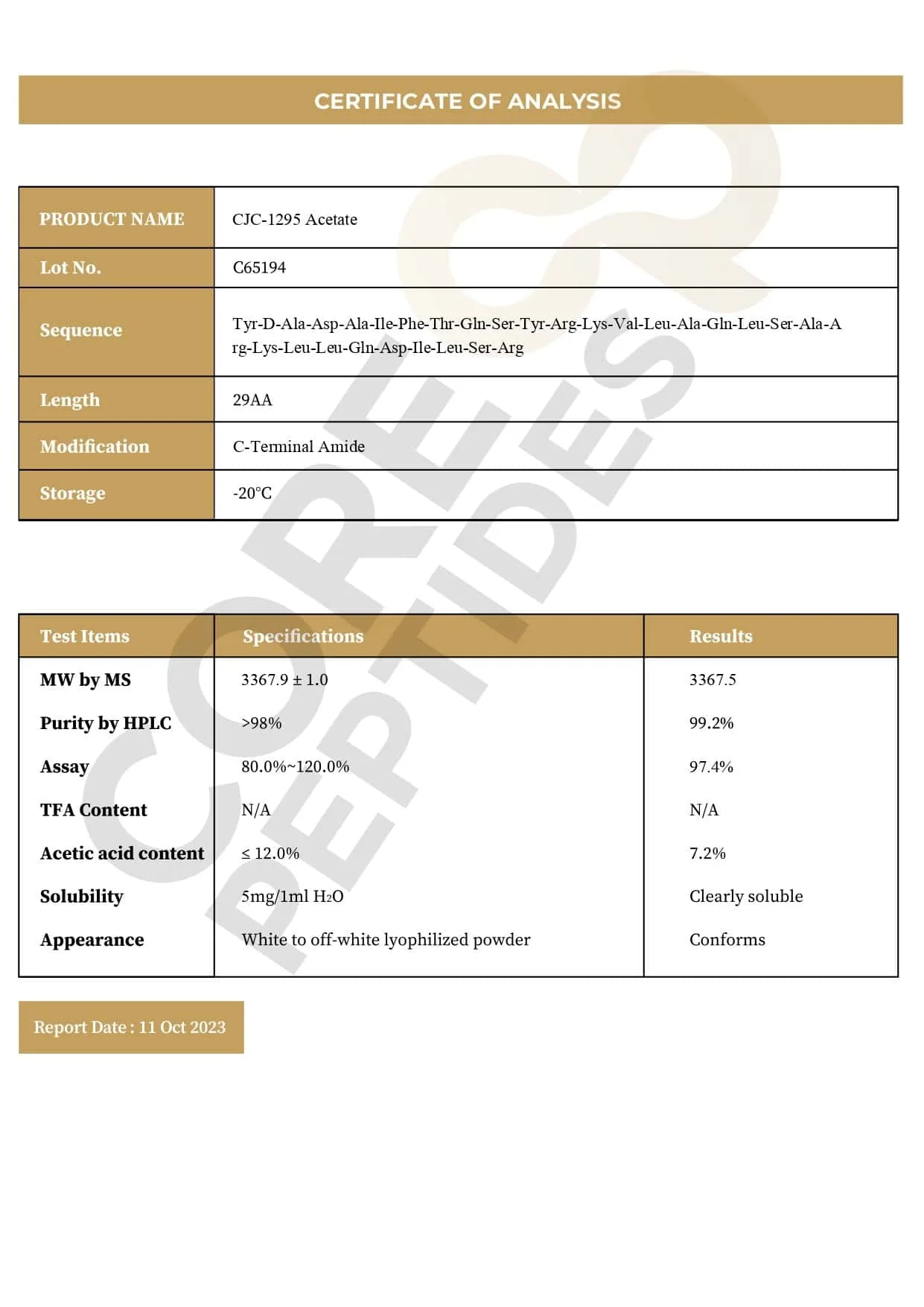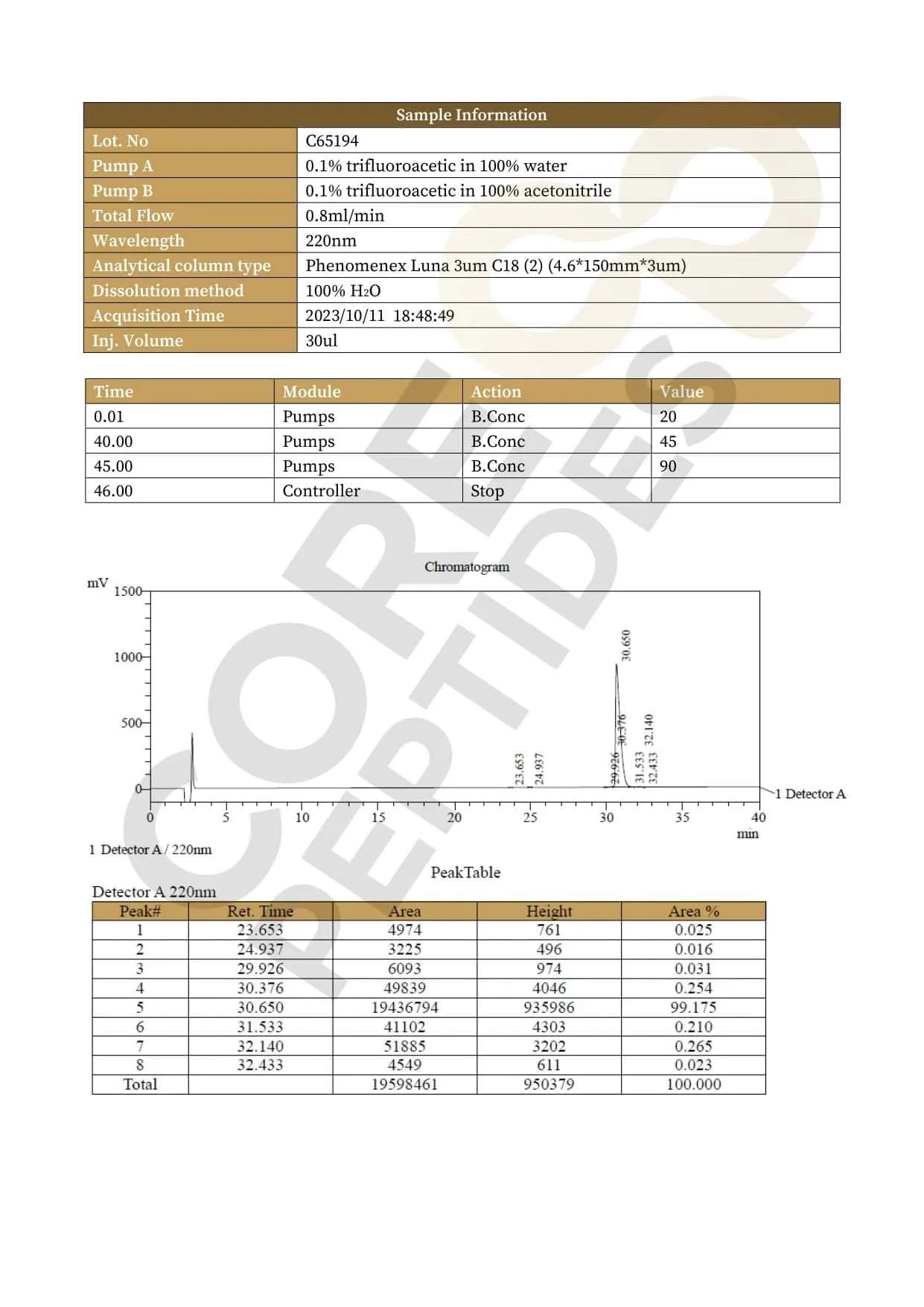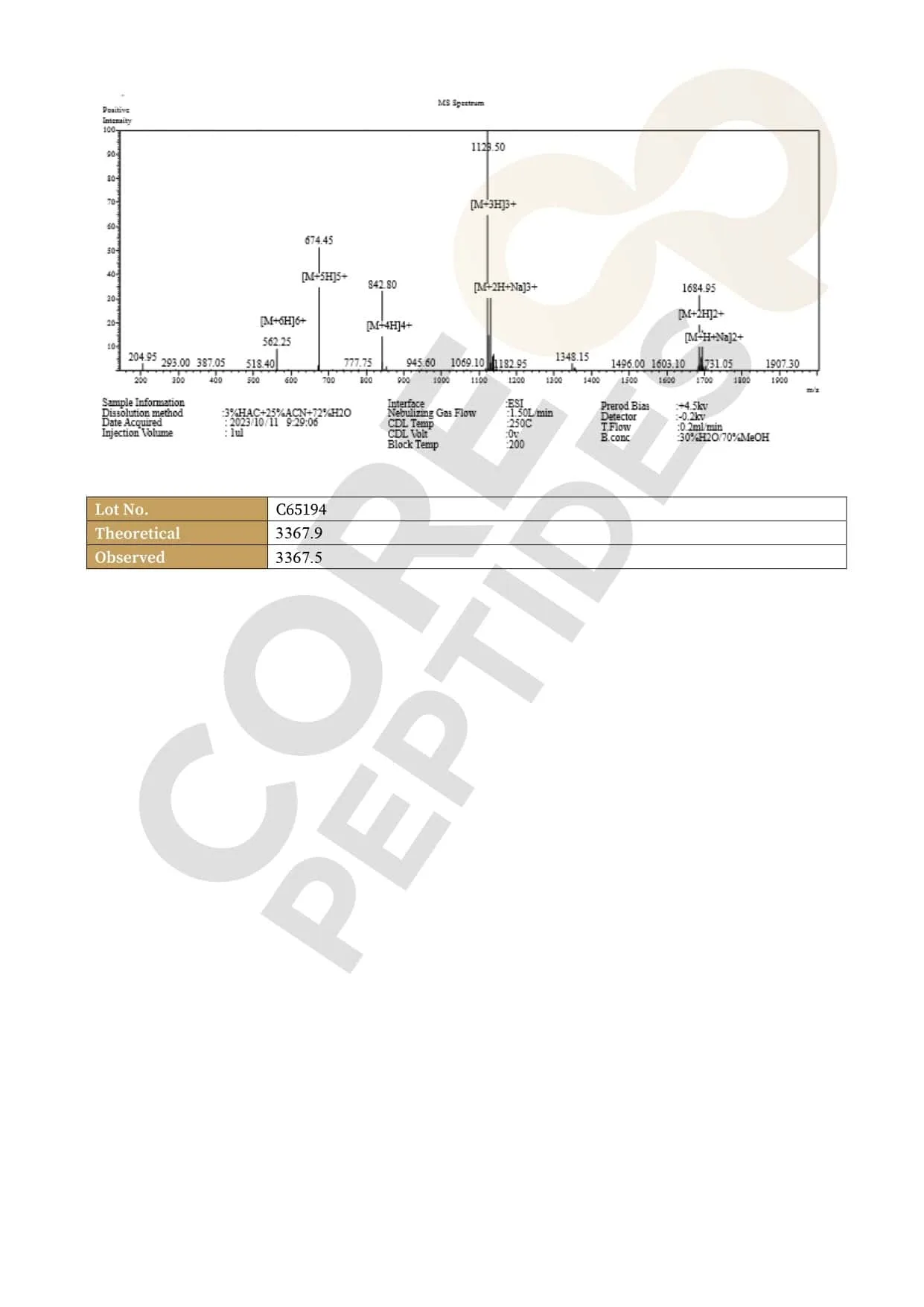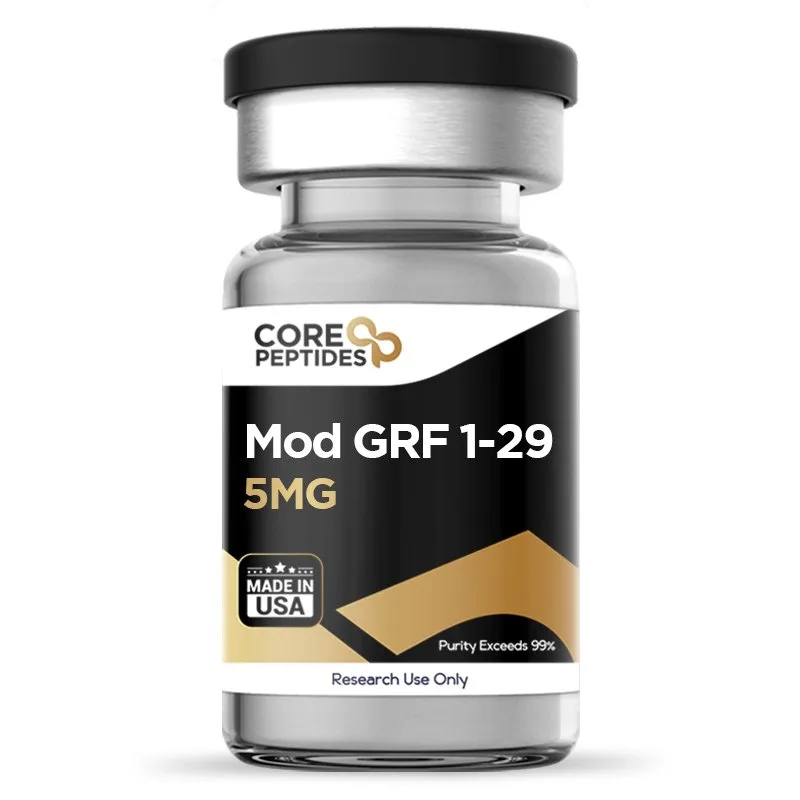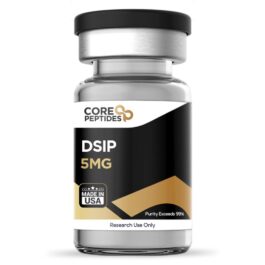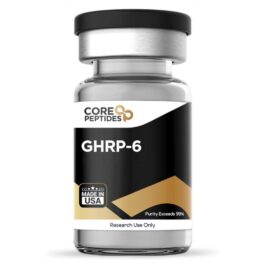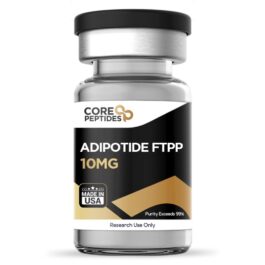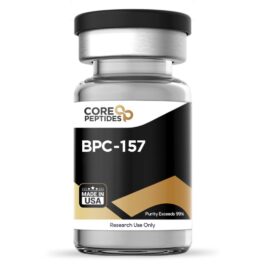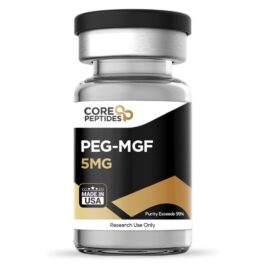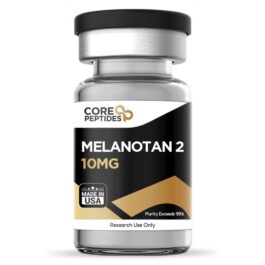CJC-1295 NO DAC (Mod GRF 1-29) (5mg)
$41.00
Size: 5mg
Contents: CJC-1295 NO DAC (MOD GRF 1-29)
Form: Lyophilized powder
Purity: >99%
SKU: P-MODGRF129
FREE Shipping on $200+ orders
Discount per Quantity
| Quantity | Discount | Price |
|---|---|---|
| 5 - 8 | 5% | $38.95 |
| 9 + | 10% | $36.90 |
CJC-1295 Peptide (No DAC)
CJC-1295 is a synthetic peptide derivative of the naturally occurring GHRH hormone and is composed of 29 amino acids.(2) This peptide is also referred to as Modified GRF (1-29) or CJC 1295 without DAC. It is a modified version of the peptide containing four substituted amino groups that are considered to help prevent the peptide's degradation. CJC without DAC does not have a Drug Affinity Complex that is sometimes added to further extend the half-life of the peptide.
Modified growth hormone fragments GRF (1-29) were first discovered in the early 1980s, when it was suggested that the first 29 amino acids of the natural growth hormone-releasing hormone might retain all the properties of the full 44 amino acid peptide.(3) One of the potential drawbacks of synthetically developed growth hormone-releasing peptides is a short half-life. Rigorous research has resulted in a supposedly stabilized, longer-lasting CJC-1295 (No DAC) peptide.(1)
Overview
CJC-1295 without DAC, alternatively known as the tetra-substituted GRF (1-29), represents a synthetic variant of the naturally occurring hormone responsible for the release of growth hormone (GHRH). Scholars have posited that it facilitates the secretion of growth hormone (GH). This compound is essentially constructed from the minimal sequence of amino acids that might bind to GHRH receptors, specifically the initial 29 amino acids of GHRH. There are notable structural differences between CJC-1295 without DAC and the unmodified fragment, primarily due to the alteration of four amino acids within the original 29 amino acids of GHRH. These changes encompass the 2nd, 8th, 15th, and 27th amino acids, and such adjustments might arguably extend the peptide's lifespan against enzymatic breakdown, particularly by enzymes like dipeptidyl peptidase-4 (DPP-4).(4)
More specifically, these alterations include:
- The replacement of L-alanine with D-alanine at the 2nd position, which is thought to bolster resistance against molecular degradation.
- The substitution of asparagine with glutamine at the 8th position, which could conceivably minimize asparagine reconfiguration and amide hydrolysis.
- The exchange of glycine for alanine at the 15th position, which is speculated to enhance bioactivity.
- The alteration from methionine to leucine at the 27th position, which is suggested to prevent methionine oxidation.
Chemical Makeup
Molecular Formula: C152H252N44O42
Molecular Weight: 3367.9 g/mol
Other Known Titles: CJC-1295 Without DAC
Research and Clinical Studies
CJC-1295 (No DAC) Peptide and the Pituitary Gland
CJC-1295 without DAC seems to aim at the GHRH receptor on pituitary cells, potentially engaging with certain binding sites on the receptor molecule. This interaction may induce alterations in the receptor's conformation, possibly sparking a chain of molecular events that might activate signaling pathways within its target cells. The induced structural changes are believed to facilitate the activation of G-proteins, signaling proteins theorized to reside on the cell's interior side of the GHRH receptor.(5) Once activated, these G-proteins might trigger the production of secondary messengers like cAMP or IP3, which are thought to act as intermediary signaling molecules, possibly amplifying the signal inside the cell. Particularly, cAMP may activate protein kinases, which are presumed to be pivotal in phosphorylating specific target proteins.(6) Protein kinases are suggested to have a potential role in managing various cell functions. The stimulation of protein kinases could lead to the phosphorylation of transcription factors, proteins that might influence gene expression regulation. These phosphorylated transcription factors may then enter the nucleus and might alter the transcription of genes linked to the synthesis and secretion of growth hormone. Consequently, the molecular activities seemingly initiated by CJC-1295 no DAC's binding may culminate in the merging of secretory vesicles loaded with growth hormone with the cell membrane. This merger may facilitate the external release of growth hormone from the pituitary cells, potentially enabling it to perform its biological functions.
CJC-1295 (No DAC) Peptide and Growth Hormone Pulsatility
While no studies directly investigate the potential of CJC-1295 no DAC (tetrasubstituted GRF 1-29), some researchers have conducted extensive experimentations with partially modified versions of GRF 1-29. One notable example is research by Khorram et al. This study on CJC-1295 no DAC explored its potential on growth hormone and insulin-like growth factor 1 (IGF-1), skin cell proliferation, muscle tissue hypertrophy, and other potential outcomes.(7) The investigation highlighted the potential of CJC-1295 no DAC to modulate the growth hormone-IGF-1 axis. More specifically, CJC-1295 no DAC appeared to cause a considerable rise, with an approximate increase of 70-107% higher mean 12-hours release of growth hormone by the somatotroph cells in the anterior pituitary. Concurrently, IGF-1 also experienced an increase, approximately 28%, indicating an enhancement in the growth hormone-IGF-1 axis functionality. This increase was also associated with increases in skin tissue thickness, potentially due to the anabolic actions of growth hormone and IGF-1 on collagen-producing skin cells such as fibroblasts. Furthermore, there was a significant increase in muscle tissue hypertrophy, ultimately resulting in a net lean mass gain of 2.77 lbs. These results imply a potential role of CJC-1295 no DAC in promoting skin cell proliferation and muscle tissue hypertrophy that should be investigated in future experiments. However, the specific mechanisms behind these actions remain to be fully elucidated.
CJC-1295 (No DAC) Peptide and Intestinal Studies
Studies(8) were conducted in experimental models, which have suggested a potential interaction between GHRH analog peptides and VPAC(1)-R, found on the smooth muscles of the gastrointestinal system. This interaction was suggested to induce bowel movement, though the potential connection between specific peptides and bowel release are still under investigation.
CJC-1295 (No DAC) Peptide and Heart Rate
Preliminary research(9) in murine models suggested that Modified GRF 1-29 peptide (along with other GHRH derivative analogs) may exhibit some potential to improve heart rate and possibly support the heart's ability to pump blood, particularly following a heart attack. The study(9) commented that GHRH agonist peptides appeared to promote cardiac tissue repair and possibly also improve ejection fraction rates.
CJC-1295 (No DAC) Peptide and Combination
CJC-1295 NO DAC appears to be a relatively short-lasting GHRH analog when not attached to DAC, compared to other synthetic GHRH peptides. Consequently, combined with other short-acting peptides, it may support longer durations for specific properties. Moreover, the peptide may have synergistic actions when combined with growth hormone secretagogues (GHSs). GHSs are considered to be ghrelin mimetics, which interact with the ghrelin receptors within various tissues. These receptors also happen to be found on the somatotroph cells in the anterior pituitary gland - the same cells that also have the GHRH receptors and are associated with growth hormone synthesis. Activating these receptors may lead to an apparent increase in growth hormone synthesis, and some researchers suggest that the simultaneous activation of the GHRH and ghrelin receptors on these pituitary cells may result in synergistically increased growth hormone elevation.(11) One such highly common peptide combination is with Ipamorelin, a synthetic GHRH pentapeptide. Both Ipamorelin and CJC-1295 peptides have been suggested to stimulate the production of growth hormone by the cells of the pituitary gland, albeit via different modes of action, therefore possibly exerting synergism and stimulating even greater growth hormone secretion.
CJC-1295 peptide is available for research and laboratory purposes only. Please review and adhere to our Terms and Conditions before ordering.
References:
- National Center for Biotechnology Information. "PubChem Compound Summary for CID 91976842, CJC1295 Without DAC" PubChem, https://pubchem.ncbi.nlm.nih.gov/compound/CJC1295-Without-DAC
- Clark, R G, and I C Robinson. “Growth induced by pulsatile infusion of an amidated fragment of human growth hormone releasing factor in normal and GHRF-deficient rats.” Nature vol. 314,6008 (1985): 281-3. https://pubmed.ncbi.nlm.nih.gov/2858818/
- The Discovery of Growth Hormone-Releasing Hormone: An Update https://onlinelibrary.wiley.com/doi/full/10.1111/j.1365-2826.2008.01740.x
- Martin, B., Lopez de Maturana, R., Brenneman, R., Walent, T., Mattson, M. P., & Maudsley, S. (2005). Class II G protein-coupled receptors and their ligands in neuronal function and protection. Neuromolecular medicine, 7(1-2), 3–36. https://doi.org/10.1385/nmm:7:1-2:003
- Newton, A. C., Bootman, M. D., & Scott, J. D. (2016). Second Messengers. Cold Spring Harbor perspectives in biology, 8(8), a005926. https://doi.org/10.1101/cshperspect.a005926
- Khorram, O., Laughlin, G. A., & Yen, S. S. (1997). Endocrine and metabolic effects of long-term administration of [Nle27]growth hormone-releasing hormone-(1-29)-NH2 in age-advanced men and women. The Journal of clinical endocrinology and metabolism, 82(5), 1472–1479. https://doi.org/10.1210/jcem.82.5.3943
- Ito T, Igarashi H, Pradhan TK, Hou W, Mantey SA, Taylor JE, Murphy WA, Coy DH, Jensen RT. GI side-effects of a possible therapeutic GRF analogue in monkeys are likely due to VIP receptor agonist activity. Peptides. 2001 Jul;22(7):1139-51. https://pubmed.ncbi.nlm.nih.gov/11445245/
- Schally AV, Zhang X, Cai R, Hare JM, Granata R, Bartoli M. Actions and Potential Therapeutic Applications of Growth Hormone-Releasing Hormone Agonists. Endocrinology. 2019 Jul 1;160(7):1600-1612. https://pubmed.ncbi.nlm.nih.gov/31070727/
- Sinha, D. K., Balasubramanian, A., Tatem, A. J., Rivera-Mirabal, J., Yu, J., Kovac, J., Pastuszak, A. W., & Lipshultz, L. I. (2020). Beyond the androgen receptor: the role of growth hormone secretagogues in the modern management of body composition in hypogonadal males. Translational andrology and urology, 9(Suppl 2), S149–S159. https://doi.org/10.21037/tau.2019.11.30
